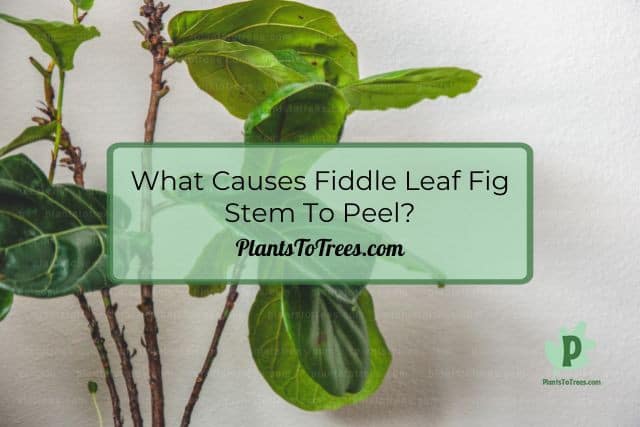Seeing your fiddle leaf fig stem peeling be a stressful experience, especially if you’re not sure what is causing the problem in the first place. Before even trying to fix the peeling problem, take the time to investigate the issue. This will not only ensure you apply the proper treatment, but it will give you the knowledge to help prevent the problem from returning.

Fiddle leaf fig stem peeling is typically the result of dryness. It could be that it isn’t getting enough water or the room where the plant is living is too dry. Both of these can cause stem peeling. The best way to fix and prevent this issue is to ensure the plant has the right amount of moisture.
Stem peeling isn’t just an aesthetic problem. It can open up the plant to a wide array of issues, ranging from weak stems to diseases. Additionally, it isn’t a problem that you should put on the back burner, since it can be fatal to the fiddle leaf fig.
What Causes Fiddle Leaf Fig Stem To Peel?

Before you can properly treat the stem peeling, you will need to figure out what is causing the problem in the first place. Once this has been determined, you can take the necessary steps to correct the stem peeling and prevent it from reoccurring.
Stem peeling is a serious problem that can be caused by various problems. The most common issue, however, that causes stem peeling is directly associated with dry conditions. This could be the fiddle leaf fig not getting enough water, low humidity levels, and temperatures too high.
Underwatering The Fiddle Leaf Fig
Not providing the fiddle leaf fig with enough water is by far the number one cause of the plant’s stems peeling. Without proper water, the plant will begin to dry out, leaves will wilt and drop, stems become weak and will peel. Thankfully, this is one of the easiest things to prevent, since all you have to do is make sure the fiddle leaf fig has enough water.
In most cases, you will need to water the fiddle leaf fig about once a week. However, this can vary depending on how dry the environment is, the age of the fiddle leaf fig, size of the plant, and time of year. In the winter, when the plant isn’t actively growing, expect to cut back on how often you water the plant once every 10 to 14 days.
Air Is Too Dry
When the air is too dry, it can cause the fiddle leaf fig leaves to curl and turn brown. If the air continues to stay dry, the stem can start to dry out and begin to peel.
Try to provide the fiddle leaf fig with at least 50 percent humidity to help prevent stem peeling. A humidifier and drip tray will both help to increase the humidity level in the room.
On extremely dry days, consider misting the fiddle leaf fig’s leaves with water to help keep the plant moist and the humidity level high.
Temperature Is Too Hot
When the temperature is too high for the fiddle leaf fig, its leaves and stems will quickly dry out. And a dry stem can start to peel.
The best treatment for this is simply moving the plant to an area that isn’t as hot. Aim for a temperature that is no higher than 80 degrees and no lower than 60 degrees.
The ideal temperature for the fiddle leaf fig is between 65 and 75 degrees, but it can tolerate temps as high as 80.
Stem Rot
Rot is a serious issue that can quickly kill your fiddle leaf fig. When rot starts to form on your plant, it can cause the stem to start to turn black, become weak, and begin to peel.
Unfortunately, it can be extremely difficult to stop rot once it has already begun. The best treatment is to prevent rot from occurring in the first place, which will include providing the fiddle leaf fig with the right care and growing requirements.
The most common cause of rot is from overwatering, which occurs when you water the plant too much or grow the plant in compact soil. Rot can kill a plant in less than 2 weeks, if conditions are ideal. This just proves how serious this issue is.
The only good thing about rot is that it is usually preventable. All you have to do is make sure you are not overwatering the fiddle leaf fig. Additionally, you need to ensure the soil the fiddle leaf fig is growing in is light and airy, and not compact.
Cankers
While dryness is the most common issue of bark peeling in the fiddle leaf fig, canker is another potential cause of stem peeling. Cankers can form as lesions on the stem of the fiddle leaf fig that seep and turn brown. The area on the stem where the canker is located can begin to peel.
Cankers are caused by fungal and bacterial pathogens, and it can sometimes be treated by applying a fungicide, such as copper fungicide, designed for use on cankers. If the infected stem is not the main branch, then you might have to prune off the infected stem to help control the disease.
Related Articles
Do Fiddle Leaf Fig Leaves Get Bigger? (How To)
Why Does My Fiddle Leaf Fig Leaves Point Up Or Down? (How To Fix/Prevent)
PlantsToTrees.com is the owner of this article and we first published this on March 5, 2023.
